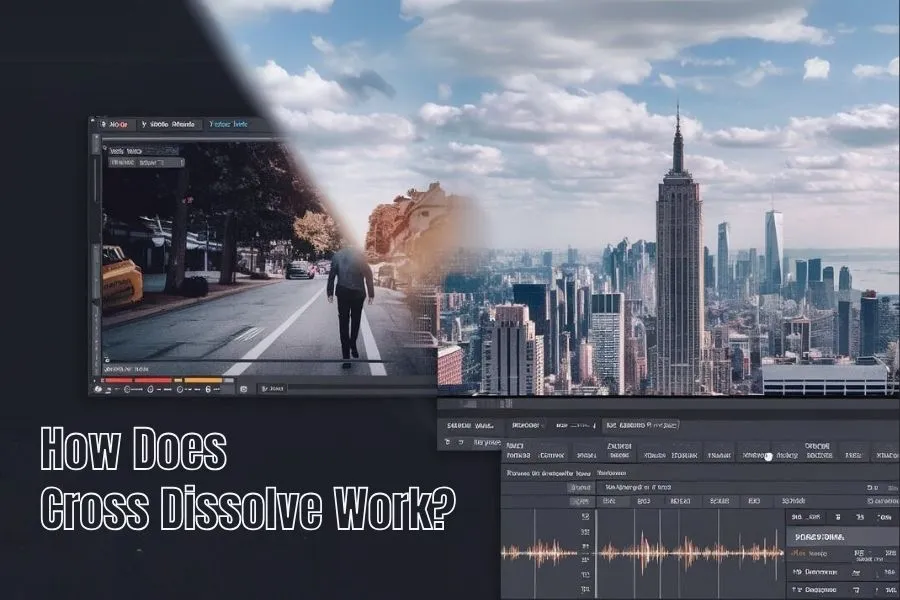Table of Contents
Introduction
Transitions play a pivotal role between shots. They dictate the rhythm of a film and impact the viewer’s perception and emotions. Among these transitions, cross dissolves have become a staple technique in modern filmmaking. But what are cross dissolves in video editing, and why are they so popular? This article dives into the function, application, and artistry behind cross dissolves, revealing how they shape storytelling across different genres.
What Are Cross Dissolves in Video Editing?
A cross dissolve is a video transition that gradually blends one shot into another. In essence, one clip slowly fades out while the next clip fades in, creating a seamless overlap between two scenes.
Why Use Cross Dissolves?
- Establishing Relationships: Connect scenes that share a thematic or narrative link.
- Depicting Time Passage: Visually represent the flow of time, such as moving from day to night or one season to another.
- Creating Dreamlike Sequences: Add a touch of surrealism or evoke a dreamlike atmosphere.
How Does a Cross Dissolve Work?

A cross dissolve is a classic video editing technique that seamlessly transitions between two scenes. It’s like a visual handshake, where one shot gently fades out as another fades in.
Here’s how it works:
- Overlap: Two video clips are placed on the timeline, overlapping each other.
- Fade Out: The first clip gradually loses transparency, becoming less visible.
- Fade In: Simultaneously, the second clip gains transparency, gradually coming into view.
Example:
Imagine a movie scene where a character is walking through a bustling market. As the camera follows them, the scene gradually fades out. Simultaneously, a new scene fades in, showing the character arriving at a quiet, serene temple. This cross dissolve visually conveys the passage of time and the change in atmosphere.
Different Uses of Cross Dissolves in Video Editing
Cross dissolves are versatile and can be used for various effects:
1. Scene-to-scene transitions:
Used to indicate a change of location or time.
Example 1: Scene-to-Scene Transition
- Use Case: A scene of a character waking up in their bedroom transitions to a scene of them walking down a busy city street.
- Effect: The cross dissolve smoothly transitions between the two locations, creating a sense of continuity and flow.
- Related Website: Adobe’s Creative Cloud page on cross dissolves provides a visual example and explanation:
https://www.adobe.com/creativecloud/video/discover/video-cross-dissolve.html
2. Passage of time:
Ideal for montages where time is condensed.
3. Soft fades: Often used in dream sequences or flashbacks to add a gentle, contemplative mood.
Types of Cross Dissolves
1. Fast dissolve:
Creates a quick transition, suitable for fast-paced edits.
Example: A quick jump between two action scenes in a fast-paced thriller.
2. Slow dissolve:
Slow dissolve relate to longer and more drawn out, providing a more dramatic shift.
Example: Transitioning from a character’s serene moment to a chaotic event, emphasizing the change in mood.
3. Overlay effects:
Combining a dissolve with additional effects like color grading to enhance transitions.
4. Soft fades:
Ideal for scenes requiring a gentle transition, such as romantic or nostalgic moments.
Example: Fading out a romantic scene with soft music to create a dreamy atmosphere.
Cross Dissolves vs. Other Transitions
Cross dissolves and other transitions offer distinct ways to connect scenes in a video.
Cross Dissolve:
- Smooth Transition: Gently blends one scene into another, creating a seamless flow.
- Conveys Time Passage: Often used to indicate the passage of time or a shift in mood.
- Example: A scene of a character waking up dissolves into a scene of them at work, suggesting the passage of morning.
Other Transitions:
- Cuts:
- Immediate Shift: Abruptly switches between scenes, often used for fast-paced action sequences.
- Example: A fight scene with rapid cuts between different angles.
- Fades:
- Gradual Change: Slowly transitions toward/from black, provide scene something beginnings or endings.
- Example: A scene fading to black after a dramatic climax.
- Wipes:
- Stylized Transition: Uses a graphic element to cover one scene and reveal the next, adding visual interest.
- Example: A vertical wipe to transition between two scenes with different settings.
How to Apply Cross Dissolves in Popular Editing Software
Whether you’re using Adobe Premiere Pro, Final Cut Pro, or DaVinci Resolve, adding a cross dissolve is straightforward:
1. Adobe Premiere Pro:
Select the Clips: Select the two clips you want to transition between.
Apply the Effect:
- Method 1: Drag the “Cross Dissolve” effect from the Effects panel onto the edit point between the two clips.
- Method 2: Use the keyboard shortcut Ctrl+D (Windows) or Cmd+D (Mac) to quickly apply the default transition.
Adjust the Duration: Drag the edges of the transition on the timeline to adjust its duration.
2. Final Cut Pro:
Select the Edit Point: Place the playhead at the edit point between the two clips.
Apply the Transition:
- Method 1: Choose “Cross Dissolve” from the Transitions panel.
- Method 2: Use the keyboard shortcut T to quickly apply the default transition.
Adjust the Duration: Drag the edges of the transition on the timeline to adjust its duration.
3. DaVinci Resolve:
Select the Edit Point: Place the playhead at the edit point between the two clips.
Apply the Transition:
- Method 1: Go to the Transitions menu and choose “Dissolve.”
- Method 2: Use the keyboard shortcut D to quickly apply the default transition.
Adjust the Duration: Drag the edges of the transition on the timeline to adjust its duration.
Conclusion
Cross dissolves are a powerful tool in a video editor’s toolkit, offering a seamless way to transition between scenes. They allow editors to guide viewers through the narrative with subtlety and grace, adding an emotional layer that other transitions may lack. Whether used to mark the passage of time, soften a mood, or create a reflective ambiance, cross dissolves enhance storytelling and elevate the visual experience.
FAQs
1. What are cross dissolves in video editing?
Cross dissolves are video transitions that gradually blend one scene into another, creating a smooth and seamless flow between clips.
2. When should I use a cross dissolve?
Use cross dissolves for transitions that require a softer, more emotional effect, such as montages, scene changes, or flashbacks.
3. What’s the difference between a cross dissolve and a cut?
While cuts immediately switch between scenes, cross dissolves blend two scenes together, creating a smoother and more gradual transition.
4. How do I add a cross dissolve in Adobe Premiere Pro?
In Adobe Premiere Pro, drag the “Cross Dissolve” effect from the Effects panel onto the timeline between your clips.
5. Can cross dissolves be combined with other effects?
Yes, you can enhance cross dissolves by layering them with other effects, such as color fades or overlays, to create unique transitions.

